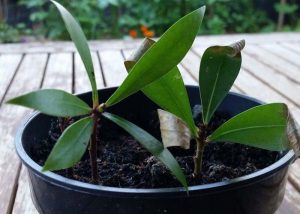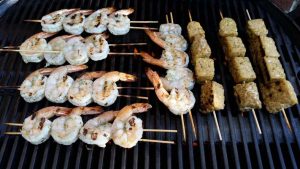One of SGA’s subscribers, Zeljko Horvatin, is a chef and is studying horticulture. He writes:
Over the last couple of years, while studying, I’ve learnt to appreciate and have even fallen in love with Australian native plants and, in particular, bushfoods. Being a chef and a gourmand switches my brain into food mode with whatever I work with. So it follows that I’ve become fascinated with how Australian native plants can be part of the menu as well as part of the garden.
My first bush tucker experiment was with Tasmannia lanceolata, also known as the Mountain Pepper.
The plant
There’s a lot of information out there about the plant in books and the internet. They all agree that T. lanceolata is a large shrub or a small tree, but when it comes to its size, there’s a range of views, suggesting that the plant grows to anywhere between three and ten meters. These discrepancies should not be a problem, unless you are short of space. I guess it can be pruned, especially if you are going to use it in cooking.
Used by Aboriginals as both food and medicine, the plant belongs to the Winteraceae family which is part of the group of plants known as palaeodicots, which are considered amongst the most primitive flowering plants because of their floral anatomy and wood structure. It is native to Tasmania and the Australian mainland, where it is mostly found in Victoria and southern NSW. It thrives in cool moist environments, in either sun or shade with well-drained soil.
The leaves are glossy dark green, narrowly elliptic, alternate clustered towards the end of the branchlets, 3-13cm long and 0.5-4cm wide on short stalks.
Flowers are creamy white and about 1cm across, grouped in clusters with curled-back petals. Male and female flowers can only be found on separate trees and it is impossible to distinguish which sex from seed alone. According to some articles it is possible to determine its gender when it flowers, with female flowers being smaller, pale cream and having only a few petals each, while male are bigger and have many more petals.
 Borne in March – May, the fruit, liked by birds, is a globular berry, shiny purple to black, about 0.5cm in diameter clustered in axils at the end of branchlets. Both the leaves and the fruit contain a peppery and hot compound called polygodial which has been examined and written about in many scientific journals. It has some serious antifungal and antibacterial properties attributed to it, but of course, before using any medicinal plant please consult your GP and medicinal plant expert. The compound polygodial is also used as an insecticide for its antifeedant properties – it causes insects to starve. Reports that the plant has antioxidant and antidiabetic properties indicate that more research on medicinal use might be very useful.
Borne in March – May, the fruit, liked by birds, is a globular berry, shiny purple to black, about 0.5cm in diameter clustered in axils at the end of branchlets. Both the leaves and the fruit contain a peppery and hot compound called polygodial which has been examined and written about in many scientific journals. It has some serious antifungal and antibacterial properties attributed to it, but of course, before using any medicinal plant please consult your GP and medicinal plant expert. The compound polygodial is also used as an insecticide for its antifeedant properties – it causes insects to starve. Reports that the plant has antioxidant and antidiabetic properties indicate that more research on medicinal use might be very useful.
Propagation is easier from cuttings because it is possible to know what sex the plant will have.
Culinary uses

And here comes the fun part – how to use it in the kitchen. Recently I have been given some cuttings of the plant so that I can propagate it for my own use, and just for the record, I have had more success with the tip cuttings than the mid-section ones. Since there were a lot of the leaves left over, I decided to dry them and save them in my herb and spice collection, and just recently used it in one of the dishes I created for lunch on a warm Aussie Sunday afternoon. I wanted it to be as Aussie as can be, and what is more Aussie than a barbie?
I found beautiful Australian prawns at the market and marinated them in white wine and a mixture of Murray river pink salt and dried crushed T. lanceolata leaves. The final result was more than pleasing for the palate.
I can describe the taste as the mixture of bay leaf and rosemary, and the smell instantly reminded me of the Mediterranean. Whoever has walked along “lungo mare” in Italy, Croatia or any other Mediterranean country will know what I mean by that.
Just a few days later I tried the berries too. I combined them in a blender with some onions and mixed them through my vegetarian koftas, which proved to be a good choice. The berries taste almost the same as the leaves, except for the sweetness you get from the flesh surrounding the peppery seed. What I found interesting was that both the seed and the leaf had that peppery heat to them, but it seemed to disappear with cooking, leaving just the taste of Mediterranean behind.
If you live in a cool region of southern Australia you might like to grow T. lanceolata. And if you have a chance to use this wonderful herb, I’d say it’s really worth it.
References
– Cronin L. (2007) Cronin’s key guide to Australian trees. Australia: Allen & Unwin.
– Costermans L. (2006) Trees of Victoria and adjoining areas: Pocket book. 6th edn. Australia: Costermans Publishing.
– NationMaster http://www.statemaster.com/encyclopedia/Tasmannia (Accessed: 9 January 2017).
– Royal Botanic Gardens Victoria https://vicflora.rbg.vic.gov.au/flora/taxon/5505a156-251b-4f32-8711-f4e08c2ab9c2 (Accessed: 9 January 2017).”
Related Articles:
Garden Journaling – Slow down to tune in.
As we move through the year and our gardens evolve, there's something magical about documenting the journey. Garden journaling is an art that enables…
The Importance of building soil health for a biodeverse, productive garden
Creating a thriving garden that not only sustains itself but also contributes to the broader ecosystem requires more than just sunlight and water.…




